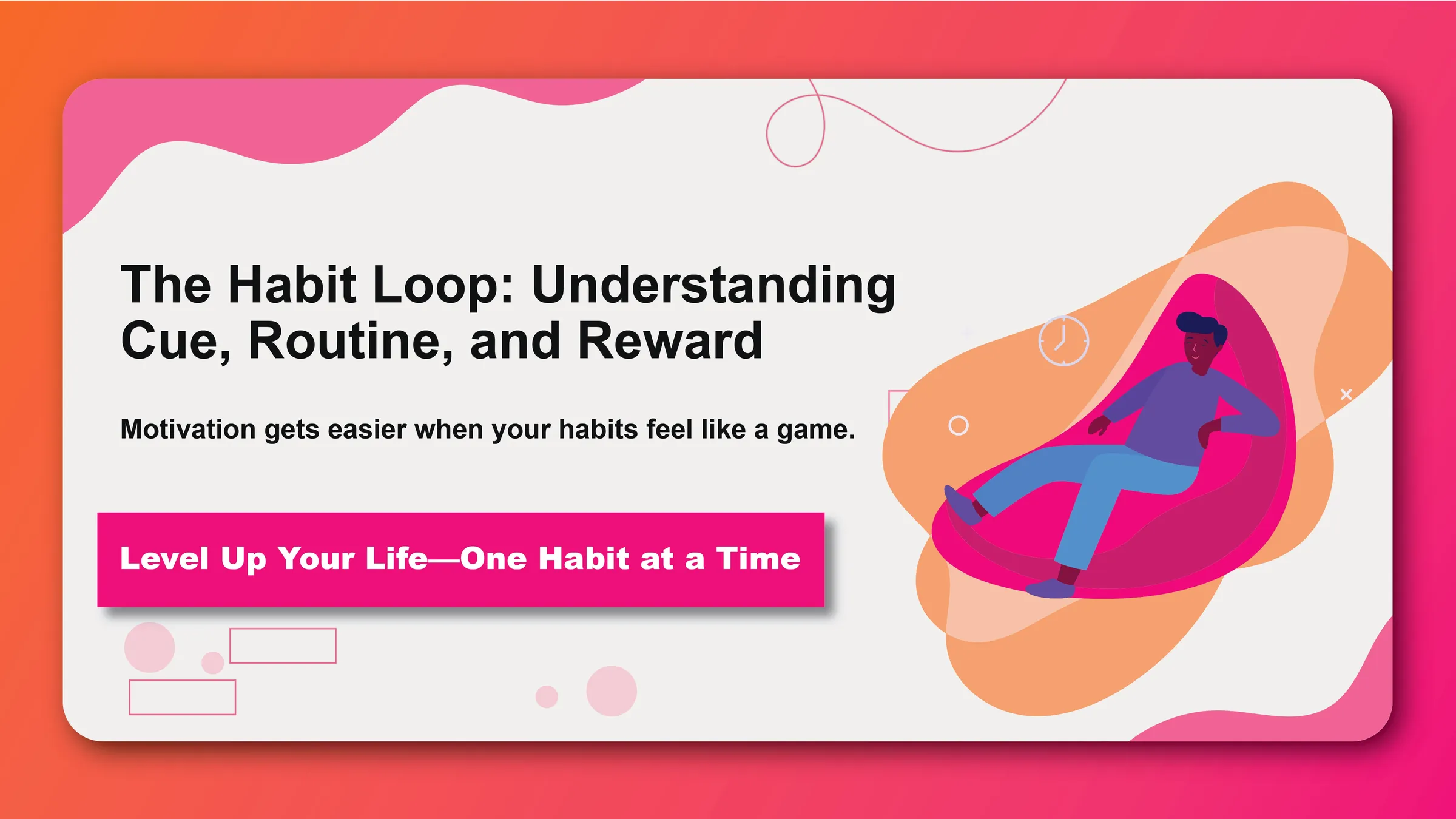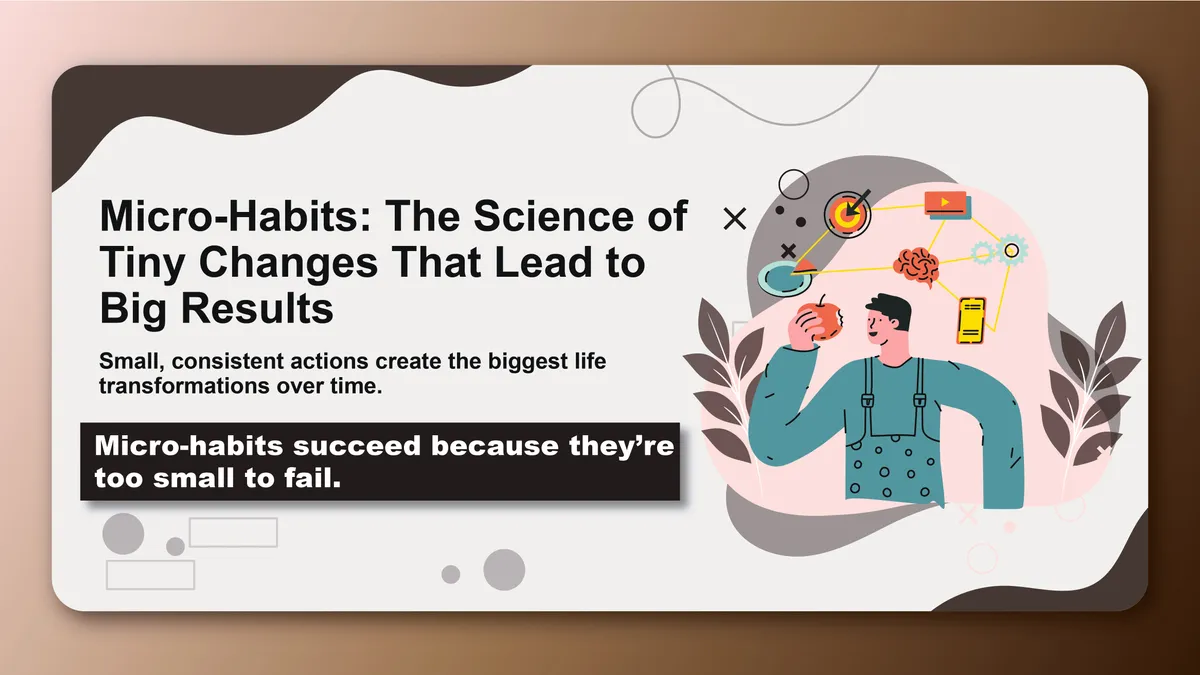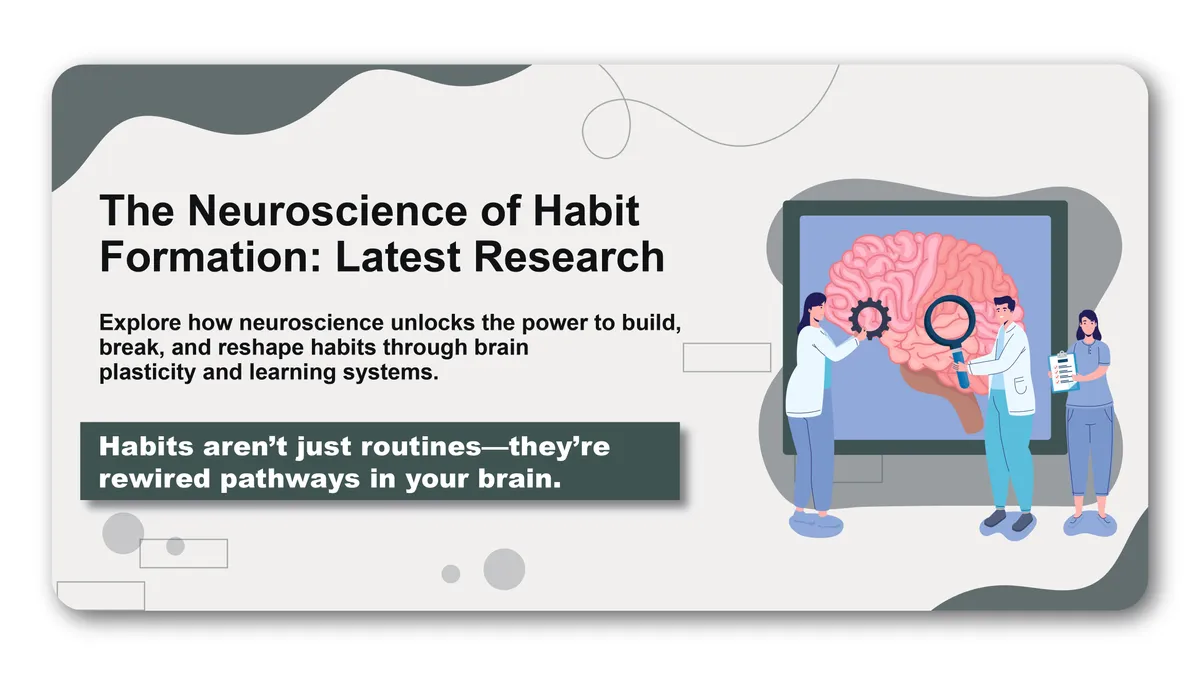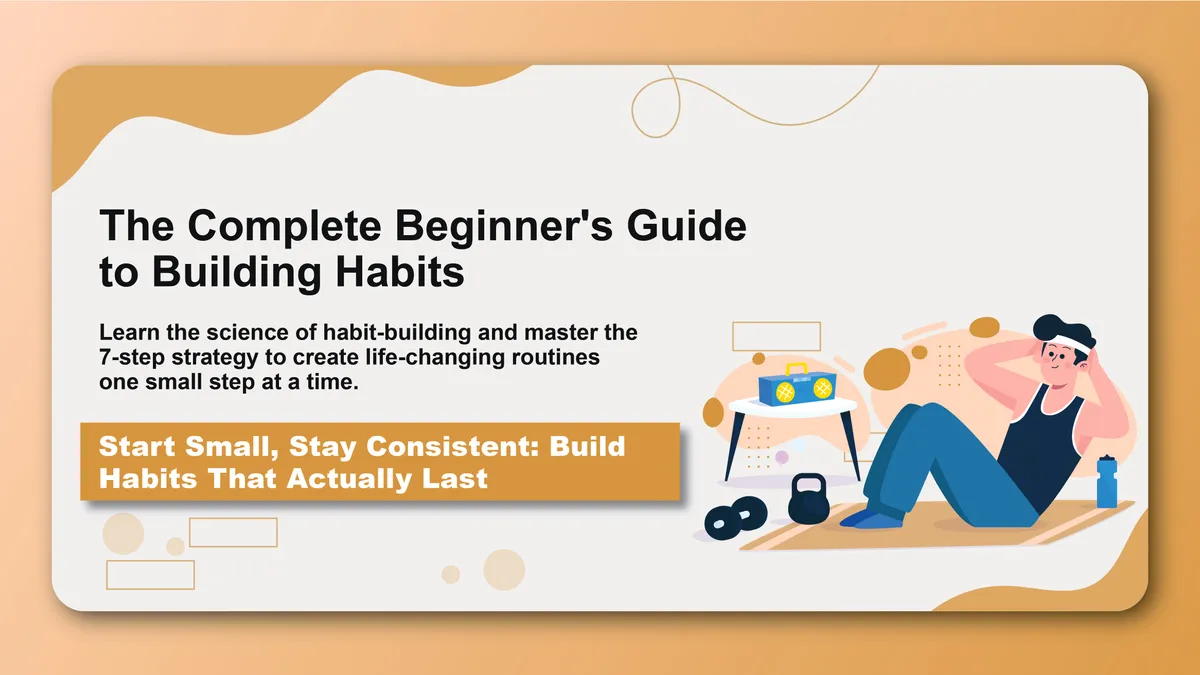Every habit you've ever formed—from brushing your teeth to checking your phone—follows the same neurological pattern. Understanding this pattern, known as the habit loop, is the key to building good habits and breaking bad ones.
In this guide, you'll learn how the habit loop works, why it's so powerful, and how you can use it to create lasting behavior change in your life.
What Is the Habit Loop?
The habit loop is a neurological pattern discovered by researchers at MIT that governs how all habits are formed and maintained. It consists of three essential components:
- Cue (Trigger): The signal that initiates the behavior
- Routine (Behavior): The action or sequence of actions you perform
- Reward (Benefit): The positive outcome that satisfies a craving
This loop operates automatically in your brain, which is why habits feel effortless once they're established. Your brain essentially puts the behavior on autopilot to conserve mental energy for more important decisions.
The Neuroscience Behind the Habit Loop
When you first learn a new behavior, your brain works hard to process each step. But as you repeat the behavior, your brain begins to create neural pathways that make the action more automatic.
The Basal Ganglia: Your Habit Center
The basal ganglia, a group of structures deep in your brain, plays a crucial role in habit formation. As habits develop, brain activity shifts from the prefrontal cortex (responsible for decision-making) to the basal ganglia, making behaviors more automatic and less conscious.
This is why you can drive to work without thinking about every turn, or why you automatically reach for your phone when you hear a notification sound.
Breaking Down Each Component
1. The Cue: Your Habit Trigger
A cue is any signal that triggers your brain to initiate a habit. Cues can be:
Environmental Cues:
- Seeing your running shoes by the door
- A notification on your phone
- The smell of coffee in the morning
- Your alarm clock going off
Emotional Cues:
- Feeling stressed
- Being bored
- Experiencing excitement
- Feeling lonely
Time-Based Cues:
- 6 AM (workout time)
- Lunch break
- Before bed
- After work
Location-Based Cues:
- Entering your car
- Sitting at your desk
- Walking into the kitchen
- Lying down in bed
Social Cues:
- Seeing a friend exercise
- Being offered food at a party
- Coworkers taking a break
- Family members watching TV
2. The Routine: Your Habit Behavior
The routine is the behavior itself—what you actually do in response to the cue. Routines can be:
Physical Routines:
- Going for a run
- Eating a snack
- Checking your phone
- Brushing your teeth
Mental Routines:
- Worrying about the future
- Practicing gratitude
- Planning your day
- Meditation
Emotional Routines:
- Getting frustrated in traffic
- Feeling excited about the weekend
- Experiencing anxiety before presentations
- Celebrating small wins
3. The Reward: Why Your Brain Remembers
The reward is what satisfies your brain and makes it remember the habit loop for the future. Rewards can be:
Physical Rewards:
- Endorphins from exercise
- Taste pleasure from food
- Comfort from a warm shower
- Energy from caffeine
Emotional Rewards:
- Sense of accomplishment
- Social connection
- Relief from stress
- Feeling of control
Mental Rewards:
- New information (checking news)
- Problem-solving satisfaction
- Creative inspiration
- Learning something new
The Habit Loop in Action: Real Examples
Example 1: Morning Coffee Habit
- Cue: Waking up and feeling groggy
- Routine: Making and drinking coffee
- Reward: Feeling alert and energized
Example 2: Social Media Checking
- Cue: Phone notification or feeling bored
- Routine: Opening social media app
- Reward: Social connection and entertainment
Example 3: Exercise Habit
- Cue: Seeing workout clothes laid out
- Routine: 30-minute workout
- Reward: Endorphin release and sense of accomplishment
Example 4: Stress Eating
- Cue: Feeling overwhelmed at work
- Routine: Eating comfort food
- Reward: Temporary emotional relief
How to Use the Habit Loop to Build Good Habits
Step 1: Design a Clear Cue
Make your cue obvious and consistent:
- Visual cues: Place items where you'll see them
- Time cues: Set specific times for habits
- Location cues: Designate specific places for behaviors
- Habit stacking: Link new habits to existing ones
Example: If you want to build a reading habit, place a book on your pillow so you see it when you get into bed.
Step 2: Make the Routine Easy
Start with the smallest possible version of your desired behavior:
- 2-minute rule: Can you do it in 2 minutes or less?
- Remove friction: Eliminate obstacles to performing the habit
- Batch similar actions: Group related behaviors together
- Use implementation intentions: Plan exactly when and where you'll do it
Example: Instead of "read for an hour," start with "read one page before bed."
Step 3: Create a Satisfying Reward
Your brain needs to feel good about the behavior:
- Immediate rewards: Don't wait for long-term benefits
- Celebrate completion: Acknowledge your success
- Track progress: Use visual indicators of your streak
- Social rewards: Share your progress with others
Example: After reading one page, check it off on your habit tracker and say "I'm becoming a reader!"
How to Break Bad Habits Using the Habit Loop
The Golden Rule of Habit Change
You can't eliminate a bad habit—you can only change it. The most effective approach is to:
- Keep the same cue
- Change the routine
- Keep the same reward
Example: Replacing Stress Eating
Original Loop:
- Cue: Feeling stressed
- Routine: Eating junk food
- Reward: Temporary emotional relief
New Loop:
- Cue: Feeling stressed (same)
- Routine: Taking a 5-minute walk
- Reward: Stress relief and endorphins (same reward type)
Step-by-Step Process
- Identify the cue: What triggers the bad habit?
- Recognize the reward: What benefit does your brain get?
- Find a new routine: What else can provide the same reward?
- Practice the substitution: Replace the routine consistently
- Plan for obstacles: Anticipate challenges and have backup plans
Common Habit Loop Mistakes
Mistake 1: Unclear Cues
Problem: Relying on motivation instead of environmental triggers Solution: Create obvious, consistent cues that don't depend on how you feel
Mistake 2: Complex Routines
Problem: Making the behavior too difficult or time-consuming Solution: Start with the smallest possible version and build up gradually
Mistake 3: Delayed Rewards
Problem: Only focusing on long-term benefits Solution: Create immediate rewards that satisfy your brain now
Mistake 4: Ignoring the Craving
Problem: Not understanding what reward your brain seeks Solution: Experiment to discover what truly satisfies the underlying need
Advanced Habit Loop Strategies
Habit Stacking
Link new habits to existing ones using the formula: "After I existing habit, I will new habit."
Examples:
- After I pour my morning coffee, I will write in my gratitude journal
- After I sit down for lunch, I will take three deep breaths
- After I close my laptop, I will do 10 push-ups
Temptation Bundling
Combine an action you need to do with an action you want to do:
- Only listen to your favorite podcast while exercising
- Only check social media after completing a work task
- Only watch Netflix while folding laundry
Environmental Design
Modify your environment to make cues more obvious:
- Place healthy snacks at eye level
- Keep your phone in another room while working
- Lay out workout clothes the night before
- Put a book on your steering wheel as a reading reminder
Tracking Your Habit Loops
To master the habit loop, you need to track your progress and identify patterns:
What to Track:
- Cue timing: When does the trigger occur?
- Routine consistency: How often do you perform the behavior?
- Reward satisfaction: How good does the reward feel?
- Environmental factors: What conditions support or hinder the habit?
Tools for Tracking:
- Habit tracking apps: Digital tools like Habityzer provide detailed analytics
- Journal: Write down observations about your habit loops
- Simple calendar: Mark successful days with an X
- Photo diary: Visual documentation of your environment and cues
Building Multiple Habit Loops
Once you've mastered one habit loop, you can create systems of interconnected habits:
Morning Routine Example:
- Cue: Alarm goes off → Routine: Get out of bed → Reward: Feel accomplished
- Cue: Feet hit floor → Routine: Drink water → Reward: Feel hydrated
- Cue: Finish water → Routine: 5-minute meditation → Reward: Feel calm
- Cue: Meditation ends → Routine: Review daily goals → Reward: Feel prepared
The Science of Habit Loop Timing
Research shows that habit loops become stronger with repetition, but the timing matters:
- Consistency beats intensity: Daily 10-minute habits are more powerful than weekly 2-hour sessions
- Same time, same place: Stable contexts accelerate habit formation
- Within 66 days: Average time for a behavior to become automatic
- The plateau effect: Habits feel harder around days 10-20, then become easier
Your Habit Loop Action Plan
Ready to apply the habit loop to your life? Follow this systematic approach:
Week 1: Observation
- Identify one habit you want to build
- Map out the ideal cue, routine, and reward
- Observe your current patterns and triggers
- Design your environment for success
Week 2-3: Implementation
- Start with the smallest possible routine
- Focus on consistency over intensity
- Track your cue-routine-reward cycle daily
- Celebrate every small win
Week 4-6: Optimization
- Refine your cues to be more obvious
- Adjust your routine if it's too difficult
- Enhance your rewards to be more satisfying
- Troubleshoot any obstacles
Week 7-8: Integration
- Notice how the habit loop feels more automatic
- Consider expanding the routine slightly
- Prepare to add a second habit if desired
- Reflect on what you've learned
Conclusion: Mastering Your Habit Loops
The habit loop is one of the most powerful tools for behavior change. By understanding how cues, routines, and rewards work together, you can:
- Build positive habits that stick
- Break negative patterns that hold you back
- Create systems that support your goals
- Transform your life through small, consistent changes
Remember: You don't need to rely on willpower or motivation. You just need to understand how your brain works and design habit loops that work with your natural tendencies, not against them.
Start with one habit loop today, and watch how mastering this simple pattern can transform your entire life.
Ready to track your habit loops and build lasting change? Join Habityzer and discover how our analytics help you understand your patterns and optimize your habit loops for maximum success.



